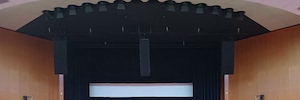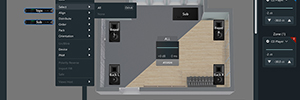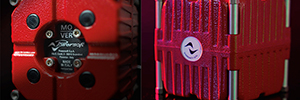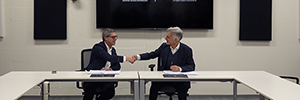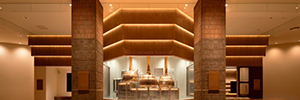Powersoft brings its technology for trips to the Moon with virtual reality
The Moon Cruise is a free-roaming VR experience, simulating a rocket launch and lunar exploration. A scene that is driven by the Mover transducers Powersoft and the Quattrocanali and Duecanali amplifiers.
 The compact transducer Mover de Powersoft and its Quattrocanali and Duecanali amplifiers play a key role in The Moon Cruise, An innovative installation of virtual reality made in Japan and that takes visitors on a Immersive trip to the Moon.
The compact transducer Mover de Powersoft and its Quattrocanali and Duecanali amplifiers play a key role in The Moon Cruise, An innovative installation of virtual reality made in Japan and that takes visitors on a Immersive trip to the Moon.
The Moon Cruise opened its doors to the public last November in Tokyo. Offer visitors an immersive virtual reality journey to the Moon, a view of Earth from space and the opportunity to walk on the lunar surface. They will also be able to take photos that they can download as a souvenir.
The Moon Cruise is a free-roaming VR experience, Permanently installed in the new Experience Center Space Travelium TeNQ, whose central theme is space travel.
 “This space entertainment center has permanent and special exhibitions, as well as workshops that offer visitors a learning experience with a unique global vision”, says Tsuyoshi Nomura, Executive Director of Styly, Experience designer.
“This space entertainment center has permanent and special exhibitions, as well as workshops that offer visitors a learning experience with a unique global vision”, says Tsuyoshi Nomura, Executive Director of Styly, Experience designer.
Styly was commissioned to create a virtual reality experience that simulated the universe, within the existing architecture.
“The area we oversee is a free-roaming VR experience, permanently installed. There are many event-themed VR environments, but none like this has been permanently realized on such a large scale”, says Nomura.
Composed of Audio Visual Communications, The facility simulates a rocket launch and lunar exploration. “Transform limited physical space into limitless virtual environments”, says Ken Yamada, Deputy General Manager of Audio Visual Communications. “The rocket launch scene, powered by Powersoft's Mover transducers and Quattrocanali and Duecanali amplifiers, Combines sound vibration and virtual reality visuals for an unforgettable sensory experience”.
“Our goal was to provide a realistic experience and surprise visitors”, says Yamada. However, Creating a compelling rocket launch experience in a confined, low-maintenance environment posed some challenges. According to Nomura, Traditional large-scale motion platforms were impractical due to their size, Maintenance requirements and safety concerns.
“A different approach was needed, and we achieved both objectives by designing new easy-to-maintain luminaires and combining them with Mover”, Yamada adds.
The compact Powersoft Mover is a Low-frequency direct-drive touch transducer, Adaptable to various purposes. Allows the audience to feel sound through haptic perception, vibrating the surrounding environment, that the human body captures, and by bone conduction, stimulates the inner ear, translating vibrations into perceptible frequencies.
Yamada explains that the compact design, Flexibility, the ease of installation and the power of the Mover made it the ideal solution for this installation.
To provide a synchronized sensory experience during rocket launch, five have been installed Transducers Mover ID in bench seats, that emit powerful vibrations that replicate the low frequencies of the BEC IC-120 speakers to create a cohesive audio-touch effect.
MoverIDs are powered by amplifiers Quattrocanali 1204 DSP and Duecanali 804 DSP, provided by Audiobrains, Japanese Powersoft Distributor.
This setup ensures a realistic rocket launch experience by combining auditory and tactile feedback with virtual reality content to create an immersive trip to the Moon.
The importance of narrative
For content design, Nomura emphasized the importance of the journey that visitors take on foot to their destination. The narrative focuses on the trip to the Moon, with special attention to the path to the lunar surface.
By emphasizing impact and experience at the starting point, The Subsequent Walk, Visual only, by the lunar surface feels more realistic.
Since the entire installation offers a learning experience, The content encourages visitors to reflect and act independently, instead of focusing solely on the story. Nomura adds that this approach provides an experience that really gives the feeling that visitors are exploring the space and acting.
The collaboration between Styly and Audio Visual Communications was instrumental to the success of the project. According to Yamada, initial testing showed that Mover provided more powerful vibration by bone conduction effects than competing products. In addition, the possibility of applying subharmonics with the Quattrocanali and Duecanali amplifiers was attractive, as it allows ultra-low frequencies to be reproduced, Necessary for rocket reproduction, No need for additional equipment.
“Vibration and sound are inseparable”, Nomura continues. “During a rocket launch, Unimaginable vibrations and energy coming from the loud noise would impact the body. Move, that vibrates with the sound source and transmits vibrations in sync with the powerful sounds linked to the images, It allows you to create an experience that feels like you're really taking off into space”.
“With Mover we manage to provide the best possible experience and, combined with content design, We achieve our client's initial goal”, Nomura concludes. From take-off to moon landing, The Moon Cruise offers a gravity-defying experience and puts the thrill of space travel within reach of visitors.
You liked this article?
Subscribe to our Feed And you won't miss a thing.






